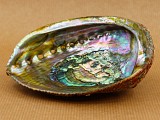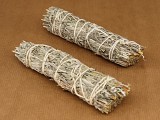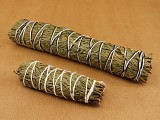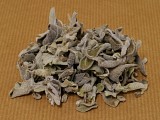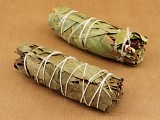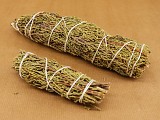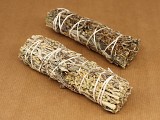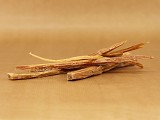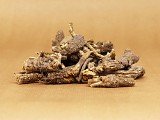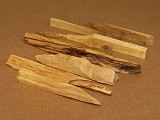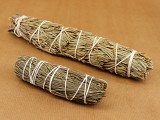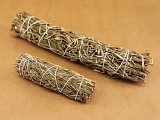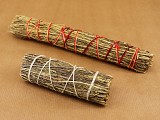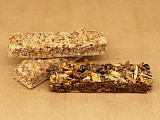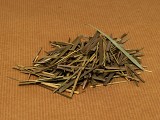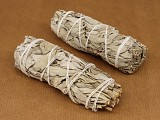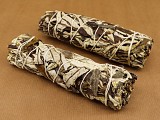Large, Grass, Braids from United States (SKU 5704)
Wonderfully fragrant braided Sweetgrass (Hierochloe odorata). Its name comes from the Greek hieros (sacred) and chloë (grass). Each braid is approx. 65 cm long and weighs around 33 g. Traditionally used after White Sage, Sweetgrass doesn’t just cleanse—it invites positive energy, blessings, and harmony. Ideal for smudging, healing, offerings, prayer, meditation, and spiritual rituals. A sacred tool for those seeking balance, connection, and renewal. Detailed information can be found below.
Each braid weighs approximately 33 gr and is 65 cm long.
Introduction
Sweetgrass (Hierochloe odorata) is a sacred plant deeply revered in many Indigenous and spiritual traditions for its sweet, soothing aroma and symbolic importance. Traditionally braided to represent the unity of mind, body, and spirit, Sweetgrass is used to call in positive energy, open ceremonial space, and reconnect with ancestral wisdom. Its soft, vanilla-like fragrance makes it not only a beautiful aromatic herb but a powerful tool for healing and spiritual grounding.
Origins and Historical Background
The name Sweetgrass originates from the Greek words hieros (sacred) and chloë (grass), highlighting its longstanding role in sacred ceremonies. In Northern Europe, it was strewn before churches on saints’ days for its pleasant scent. In North America, it has been used by Indigenous peoples for generations—as incense, in basket weaving, and even as a natural insect repellent. Its sweet aroma has also led to its use in European flavorings, including perfumes, candy, tea, and vodka such as the Polish Żubrówka.
Bison Grass Vodka
Żubrówka, also known as Bison Grass Vodka, is a unique Polish spirit infused with a blade of Hierochloe odorata—commonly known as Sweetgrass or Bison Grass. This aromatic grass grows in the Białowieża Forest, one of Europe’s last primeval woodlands, and is a favorite grazing plant of the European bison (żubr in Polish), from which the vodka takes its name. The single blade placed inside each bottle is not just for visual effect—it imparts a subtle herbal flavor with notes of Vanilla, Hay, and Almond. Traditionally enjoyed chilled or mixed with apple juice (in a cocktail affectionately called a "Tatanka"), Żubrówka holds a special place in Polish cultural and culinary heritage.
Traditional and Cultural Uses
Sweetgrass is one of the Four Sacred Medicines in Anishinaabe, Bode’wad mi, and Odawa teachings, alongside Tabaco, Cedar, and Sage. Often referred to as the “hair of Mother Earth,” it carries a soft, sweet scent when burned and is used to invite positive energy, good spirits, and healing. It is traditionally braided using 21 strands, each with deep symbolic meaning. The first seven strands represent the seven generations behind us—those who walked before, shaped our paths, and passed down wisdom. The next seven strands embody the Seven Sacred Teachings: Love, Respect, Honesty, Courage, Wisdom, Truth, and Humility—principles meant to guide our daily life and relationships. The final seven strands represent the seven generations yet to come—our children, grandchildren, and descendants still unborn—reminding us of our responsibility to live with foresight and care for future generations. The three-part braid itself is often interpreted as a symbol of unity in mind, body, and spirit, or alternatively, love, peace, and harmony—reflecting the interconnected nature of all beings. Harvested with respect and never pulled from the roots, sweetgrass is cut and dried before braiding, a process often carried out with prayer and intention, reinforcing its sacred role in Indigenous culture.
Ritualistic and Spiritual Uses
In ceremonies, Sweetgrass is often burned after Sage. While Sage is used to cleanse and remove negative energy, Sweetgrass is burned to invite positive energies, good spirits, and blessings. It smolders without an open flame, releasing a slow, sweet smoke. The smoke is fanned over people, objects, or spaces to purify and uplift. Elders say Sweetgrass is a kindness medicine—gentle and welcoming. Burning it is an act of remembering, a way to reopen the spiritual trails that connect us to our ancestors, many of which have been disrupted by colonization, displacement, and modern development.
Sustainable Harvesting and Conservation Efforts
Botanically, Sweetgrass is a perennial plant in the Poaceae family. It grows in northern climates, thriving in wetlands, meadows, and cool forest edges. Reaching up to 60 cm in height, it has long, shiny leaves and a dense root system of rhizomes, making it a resilient groundcover. However, increased demand and habitat loss have raised concerns about sustainability. Ethical harvesting practices, Indigenous stewardship, and supporting small-scale growers are essential to ensure Sweetgrass continues to thrive both spiritually and ecologically.
Conclusion
Sweetgrass is much more than a fragrant herb. It is a bridge between past and future, a sacred connector between people, Earth, and spirit. In every braid lies a story: of ancestry, teachings, and responsibility. Whether used in ceremony, healing, or quiet reflection, Sweetgrass invites us to walk gently, speak truthfully, and live with reverence—for those who came before us and those who will follow.
For a detailed overview of Sweetgrass, please refer to the full article.
Disclaimer
The information provided above is for historical, educational, and scientific purposes only. It should not be interpreted as a recommendation for the specific use of our products. Any statements about traditional uses are informational. The use and application of our products are the customer's decision and responsibility.
Copyright Notice
All content, including this article, is protected under copyright law. Any unauthorized reproduction, distribution, or use of this material is prohibited. Duplication of this content, in whole or in part, without written consent, is a violation of copyright regulations.
Other names: Sweetgrass, Holy Grass, Mary's Grass, Vanilla Grass, Bluejoint, Buffalo Grass, Zebrovka
This item is not allowed in the following countries:
Taiwan
This is a natural product, used as incense or in perfumery, or as an ingredient of incense and other perfumery or potpourri preparations.
Some incense plants or products may have some history of other folklore purposes, but we offer this product for its use as incense. Not food grade, not for consumption.
Please read our Terms & Conditions before placing your order.
